Midwest Electric Railway facts for kids
| Overview | |
|---|---|
| Headquarters | Mt. Pleasant, Iowa |
| Reporting mark | MERA |
| Locale | Mt. Pleasant, Henry County, Eastern Iowa |
| Dates of operation | 1971–Present |
| Technical | |
| Track gauge | 4 ft 8 1⁄2 in (1,435 mm) standard gauge |
| Length | 2.5 mi (4.0 km) |
The Midwest Electric Railway (MERA) is a special railway that runs historic trolleys, also known as streetcars. It is a non-profit group, which means it uses the money it makes to preserve these cool old vehicles.
You can find this railway on the grounds of the Midwest Old Threshers Reunion in Mt. Pleasant, Iowa. It has 10 historic trolleys that you can ride on a 2.5-mile track that goes around the campgrounds.
Contents
A Trip Back in Time
The Midwest Electric Railway is run by volunteers who love trolleys. They operate a tourist railroad where you can ride electric streetcars around the large campground of the Midwest Old Threshers Reunion.
Ticket prices and opening times can change during the year. The busiest time is during the five days before Labor Day for the big reunion event. The trolleys also run on special holidays or for private groups. It's a good idea to check the Old Threshers Reunion website for the most current information.
All the tracks were built and are taken care of by dedicated volunteers. Every year, they work together to maintain and repair the railway.
Where to Find the Railway
The Midwest Electric Railway is located in Mt. Pleasant, Iowa, on the grounds of the Midwest Old Thresher's Reunion. The main building, where the trolleys are stored and fixed, is a silver-painted trolley barn on S. Locust Road.
History of the Railway
The Midwest Electric Railway was started in 1971. It was created as a non-profit group to save historic electric trolleys that once ran in Iowa. The goal was to let people ride them around the campground during the Midwest Old Thresher's Reunion.
Today, the mission is still the same, but now they also save trolleys from outside of Iowa. The trolley stops include The Trolley Depot, the Trolley Barn, the Log Village, Midway, South 40, and Campers' Gate.
The Trolley Collection
The railway has a fascinating collection of trolleys from different places and times.
| No. | Image | Type | Built | Former Operator | Acquired | Notes | |
|---|---|---|---|---|---|---|---|
| 9 |  |
Suburban Passenger Car | Barber Car Co. | 1912 | Albia Interurban Railway, Southern Iowa Railway | 1968 | This car was originally built with 4 wheels but was later rebuilt to have 8 wheels. |
| 320 | 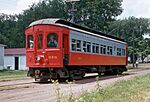 |
High-speed Interurban Car | Jewett Car Company | 1914 | Chicago Aurora and Elgin Railroad | 1968 | This heavy car was built for long-distance travel and could reach speeds of 80 MPH. |
| 381 | 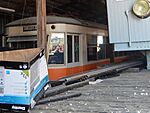 |
City Streetcar | Perley Thomas | 1930 | Knoxville Power & Light, Waterloo, Cedar Falls and Northern Railway | 1971 | This was the last streetcar to run in a city in Iowa. It was a "Safety Car," a special design where the doors only opened when the car was stopped, making it safer for passengers. |
| 3 |  |
Snow sweeper | McGuire-Cummings Manufacturing Company | 1911 | Iowa Traction Railway | 1973 | This snow sweeper is now preserved at the Rockhill Trolley Museum. |
| 1718 | 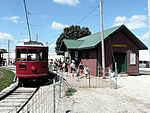 |
Open-Bench Summer Car | Rio de Janeiro, Brazil | 1911 | Rio de Janeiro Tramway | 1973 | These open cars were perfect for summer travel and had a side step that ran the full length of the car. |
| 1779 | 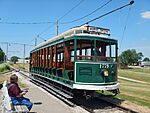 |
1970 | |||||
| 4476 | PCC streetcar | St. Louis Car Company | 1949 | Toronto Transportation Commission | 1982 | These cars were acquired by the Gomaco Trolley Company in 2002. | |
| 3093 | Pullman-Standard | 1944 | Massachusetts Bay Transit Authority | 1992 | |||
| 3226 | 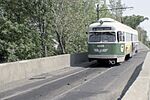 |
1945 | |||||
| 3279 | 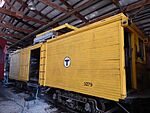 |
Line Car | Boston Elevated Railway | 1912 | Massachusetts Bay Transportation Authority | 1995 | A line car is used for maintaining the overhead electrical wires. |
| 1100 |  |
Freight Car | American Car Company | 1917 | Keokuk, Iowa | 2002 | This is a flat car used for carrying freight. |
| 1705 | 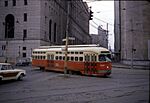 |
PCC streetcar | St. Louis Car Company | 1949 | Pittsburgh Railways | This car was sold in 2018 to be restored for a new park in California. | |
| 1811 | 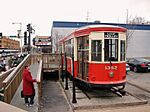 |
Peter Witt streetcar | Carminati & Toselli, Milan | 1927 | Azienda Trasporti Milanesi | 2025 | These lightweight cars from Milan, Italy, were designed for fast service on narrow city streets. |
| 1945 |  |
2002 |
Historic Buildings
The railway also has some interesting historic buildings.
The old train depot from Yarmouth, Iowa, was moved to the fairgrounds. It was once used as the ticket office and gift shop. Today, it is used as a ticket office again and adds to the old-time feel of the railway.
The Trolley Barn was built in the 1970s to store the trolleys. It has a maintenance pit underneath the tracks, which makes it easier for volunteers to work on the streetcars.
Fun Events
Midwest Old Threshers Reunion
Every year before Labor Day, volunteers operate the trolleys to take visitors around the campground. You can ride to the Log Village to see what life was like on the Iowa prairie in the 1800s. Campers also use the trolleys to get to the main fairgrounds.
Haunted Trolley Ride
Around Halloween, the railway hosts a spooky haunted trolley ride for some scary fun.
Trolley School
Once a year in June, the Midwest Electric Railway holds a Trolley School. This is a special class where you can learn how to operate a real trolley and even get to drive some of the historic streetcars.
See also
- List of United States railroads
- List of Iowa railroads
- List of heritage railroads in the United States
- List of railway museums

